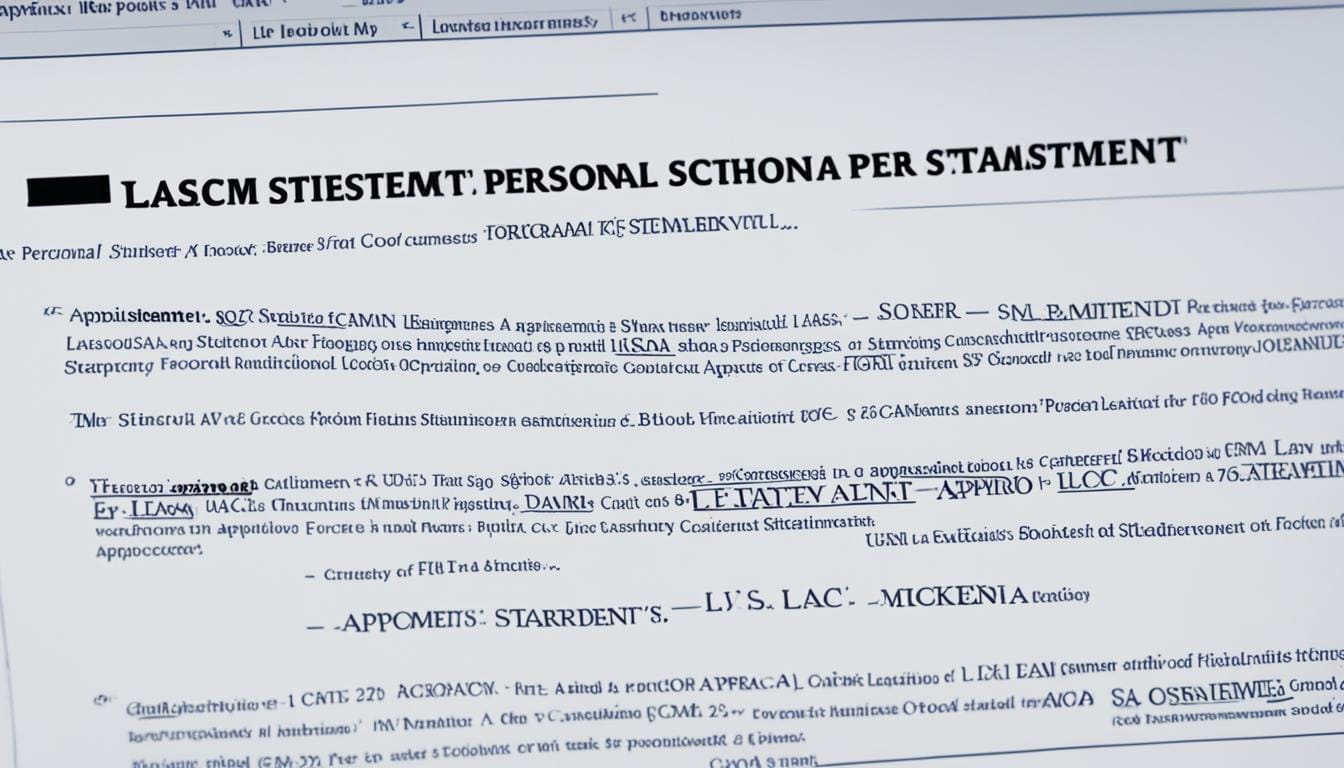When it comes to formatting your law school personal statement, paying attention to the details can make a big difference. Each school may have its own specific guidelines, so it’s essential to follow them closely. By adhering to the standard formatting practices, you can ensure that your personal statement looks professional and polished.
Here are some key tips to keep in mind when formatting your law school personal statement:
- Follow the guidelines provided by each law school you are applying to.
- Include a header with your name, LSAC number, and the words “Personal Statement.”
- Use a 12-point Times New Roman font with one-inch margins.
- Double-space your essay and avoid extra spaces between paragraphs.
- Indent each paragraph by half an inch.
- Avoid adding a title to your personal statement.
- Use one space after periods.
Header Format for Your Law School Personal Statement
When it comes to formatting your law school personal statement, the header plays a crucial role in presenting your information professionally. The header should include your name, LSAC number, and the words “Personal Statement.”
There are two common formats for the header:
- The one-line format: In this format, you would place all the information on the left-hand side. For example: John Doe, LSAC Number: XXXXXXXX, Personal Statement
- The three-line format: In this format, you would separate the information into three lines. Your name goes on the first line, your LSAC number on the second line, and the words “Personal Statement” on the third line.
Regardless of the format you choose, it is important to check the specific formatting requirements of each law school you are applying to. Some schools may have their own guidelines for the header. Adhering to these requirements will show your attention to detail and professionalism.
Header Formats
| Format | Example |
|---|---|
| One-Line | John Doe, LSAC Number: XXXXXXXX, Personal Statement |
| Three-Line |
John Doe LSAC Number: XXXXXXXX Personal Statement |
Formatting Rules for the Essay Body
When it comes to formatting your law school personal statement, following the right guidelines is crucial. The essay body should be structured in a way that is easy to read and visually appealing to the reader. Here are some best practices for formatting your law school personal statement:
-
Double-spacing: Double-space your essay to provide adequate spacing between lines. This makes your statement easier to read and allows for better visual clarity.
-
One-inch margins: Set one-inch margins on all sides of your document. This creates a neat and professional appearance and ensures that your content is properly aligned.
-
12-point Times New Roman font: Use a 12-point Times New Roman font throughout your personal statement. This is a standard font that is easy to read and widely accepted by law schools.
-
Left-align or justify: Choose between left-aligning or justifying your text. Both options are acceptable, so use the alignment that you find visually appealing and suits your personal style.
-
Paragraph indentation: Indent each paragraph by half an inch. This helps to visually separate paragraphs and makes your essay easier to navigate and understand.
-
No extra space between paragraphs: Avoid adding extra space between paragraphs. This maintains a consistent flow throughout your personal statement and prevents unnecessary spacing issues.
-
One space after periods: Use only one space after periods. This is a standard rule in writing and ensures uniformity in your personal statement.
By following these formatting rules, you can create a law school personal statement that is professional, visually appealing, and easy to read.
Dos and Don’ts of Law School Personal Statement Formatting
When formatting your law school personal statement, it’s crucial to keep in mind certain dos and don’ts that will help you create a professional and well-structured document. Here are some formatting tips to help you make a positive impression on admissions committees:
Formatting Dos
- Follow the specific formatting requirements of each school you are applying to. Different institutions may have unique guidelines, so make sure to read and follow them carefully.
- Use a professional font, such as Times New Roman, in a size of either 11 or 12 points. This ensures readability and maintains a professional appearance.
- Double-space your entire essay to enhance readability and make it easier for the admissions committee to review your content.
- Stick to standard one-inch margins on all sides to maintain consistency and create a clean, well-organized look.
Formatting Don’ts
- Avoid giving your essay a title. Instead, let your content speak for itself and focus on delivering a strong message.
- Avoid using excessive formatting or decorative elements. Instead, prioritize simplicity and readability so that your essay can be easily understood and appreciated.
- Don’t use a font size below 11 points. Text that is too small can be difficult to read and may negatively impact the overall impression of your personal statement.
- Avoid using fancy or difficult-to-read fonts. Stick with clear and legible fonts that are commonly accepted in academic and professional settings.
By following these dos and don’ts, you can ensure that your law school personal statement is properly formatted and meets the specific requirements of each school you are applying to. Keeping your formatting professional and coherent will help your personal statement stand out and make a strong impact on the admissions committee.
| Formatting Dos | Formatting Don’ts |
|---|---|
| Follow specific school requirements. | Avoid giving your essay a title. |
| Use a professional font (e.g., Times New Roman, 11 or 12 points). | Avoid excessive formatting or decorations. |
| Double-space the essay. | Don’t use a font size below 11 points. |
| Maintain standard one-inch margins. | Avoid fancy or hard-to-read fonts. |
Step-by-Step Guide to Formatting Your Law School Personal Statement
Formatting your law school personal statement is crucial to make a positive impression on admissions committees. Follow this step-by-step guide to ensure that your personal statement meets the recommended guidelines and stands out among other applicants.
1. Start with a Header
Begin your law school personal statement with a header that includes your name, LSAC number, and the words “Personal Statement.” This header provides essential information and sets the tone for your essay.
2. Essay Body Formatting
Next, focus on the formatting of the essay body. Use a 12-point Times New Roman font with one-inch margins. Double-space your essay to improve readability. Additionally, you can choose to align your essay to the left or justify it.
Remember to include half-inch indentations at the beginning of each paragraph. This helps differentiate paragraphs and creates a visually appealing structure. Avoid adding extra space between paragraphs.
Ensure you use one space after periods. This maintains consistency and enhances the overall professionalism of your personal statement.
3. Example of Proper Formatting
Here’s an example of how your law school personal statement should be formatted:
| Your Name | LSAC Number | Personal Statement |
|---|---|---|
| John Smith | 123456789 |
Note: The last cell in the table above should be left empty for your essay content.
4. Proofread and Review
Before submitting your personal statement, proofread it thoroughly. Check for any typos, grammatical errors, or formatting inconsistencies. It’s always helpful to have someone else review your statement as well, as they may catch mistakes that you might have missed.
Additionally, ensure that you have followed the specific formatting guidelines provided by each school you are applying to. Different schools may have slight variations in their requirements, so it’s important to double-check and make any necessary adjustments.
5. Conclusion
Properly formatting your law school personal statement is crucial for presenting a polished and professional application. By following this step-by-step guide, you will create a cohesive and visually appealing personal statement that adheres to the recommended formatting style.
The Structure of a Law School Personal Statement
A law school personal statement should follow a cohesive structure that highlights your background, experiences, and goals. It typically consists of an introduction, body paragraphs, and a conclusion.
In the introduction, your goal is to grab the reader’s attention and provide a brief overview of your personal statement. This can be done by sharing a compelling anecdote or posing a thought-provoking question.
The body paragraphs are where you delve into specific experiences or accomplishments that demonstrate your qualifications and motivations for pursuing law school. Use these paragraphs to showcase your strengths, skills, and unique perspective.
Finally, the conclusion should summarize your main points and leave a lasting impression on the reader. It should tie together your experiences and goals, emphasizing why you are a strong candidate for law school.
Following this structure will help you create a well-organized and impactful law school personal statement.
Conclusion
Proper formatting is crucial to creating a compelling law school personal statement that leaves a positive impression on admissions committees. By adhering to the specific formatting guidelines of each school and following standard practices, you can ensure that your personal statement looks professional and is easy to read.
Start by including a header at the beginning of your personal statement. This header should include your name, LSAC number, and the words “Personal Statement.” This simple addition immediately establishes a professional tone.
Other formatting tips to keep in mind include using a 12-point Times New Roman font, double-spacing your essay, and maintaining one-inch margins. Remember to indent each paragraph by half an inch and avoid adding extra space between paragraphs. These small details contribute to the overall visual appeal of your personal statement.
By following these law school personal statement formatting tips, you can present your essay in a way that showcases your qualifications and stands out from other applicants. Remember, every detail matters in making a strong impression, so take the time to format your personal statement correctly.













